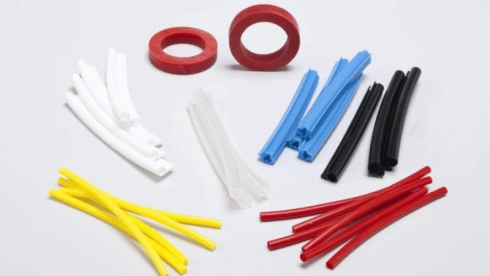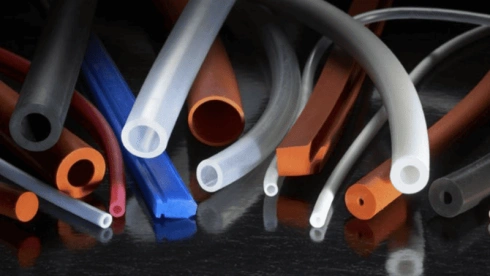Silicone and silicone rubber are both elastomers. The main difference between silicone and silicone rubber is that rubber contains bonds of carbon and carbon, whereas silicone contains bonds of oxygen and silicon.
Apart from the polymer chains of silicone and silicone rubbers, there are several other differences. Keep reading this article to learn more about the differences between silicone rubber and silicone.
Difference between Silicone and Silicone Rubber

Even though both silicone and silicone rubber are elastomers, their atomic structure differs from others. Due to the difference in nuclear structure, both elastomers have unique properties and exhibit different characteristics.
Source
Silicone is a synthetic material. Some chemical additives are added to silicone, which becomes synthetic. In comparison, silicone rubber can be both natural as well as artificial. Rubber is an extract from rubber plants.
Backbone Structure
The backbone structure of silicone and silicone rubbers vastly differs. On the one hand, silicone rubber has carbon bonds, whereas on the other hand, silicone has a silicon-oxygen bond. Due to this difference in the polymer chains of these two substances, they differ.
Oil Resistance
Silicone rubber is not oil-resistant. Because it is not compatible with oil, it is more likely to wear out on oily and greasy surfaces. Silicone is preferred when it comes to being used with oil and grease.
Temperature Resistance
Both silicone and silicone rubber can be used in low temperatures. But the threshold for high temperatures varies between the two. The temperature that silicone can stand is from -50 degrees Celsius to 230 degrees Celsius. The temperature range that silicone rubber can function in is -50 degrees Celsius to 80 degrees Celsius.
These ranges imply that we can choose either lower temperatures or higher temperatures. Silicone is preferred over silicone rubber. You should also note that silicone has much better flame resistance than the other.

Thermal Insulation
Silicone is used for insulating because, compared to other rubbers, it can resist high temperatures and provide better thermal insulation.
As silicone rubbers are less heat resistant, they are not an appropriate choice when choosing a material for thermal insulation.
Tear Properties & Tensile Strength
Because silicone rubbers can not sustain very high temperatures, they are more likely to face wear and tear at high temperatures. On the other hand, silicone is compatible with higher temperatures, and its threshold of tear properties is more elevated than silicone rubbers.
Other than in high temperatures, silicone rubber has much better tensile strength than silicone. The tensile strength of silicone rubber is approximately 25MPa, whereas silicones are approximately 5MPa.
Also, silicone rubbers have higher abrasion resistance than silicone. Silicone rubber is preferred over silicone, with a high chance of abrasion.
Flexibility & Weather Resistance
For outdoor applications, silicone is preferred as it has better resistant properties against weather conditions. Silicone is resistant to Ozone attacks, Ultraviolet rays, chemical attacks, heat, and fungus attacks. At the same time, silicone rubber has less resistance when it comes to Ozone attacks, Ultraviolet rays, chemical attacks, heat, and fungus attacks.
Advantages, Uses, and Drawbacks of Silicone
/silicone-baking-molds-5ae27a9143a1030036784001.jpg)
Advantages & Uses of Silicone
Pure Material
Silicone is known for its colorlessness. It has no odor and can be used in the food, pharmaceutical, and medical industries without harm. Where high-grade purity is required without any impurities, the silicones are processed in ISO 7 rooms where any external germs found on the silicone are killed, and the silicone is purified 100%.
Resistance and Firmness
The silicone resists oils. However, it can be improved by the use of additives in silicone.
Malleable and Adaptable
Silicone is known best for its flexibility as it resists significant distortions and works best in engines and machinery. It is highly recommended to use it where adaptability is required. Additives can be added to the silicone to modify its characteristics and open a gateway to a broader range of application opportunities.
Antimicrobial Agent
Silicones already have the properties of antibacterial functions. However, you can enhance this characteristic by adding specific additives to attain the desired purity. This makes silicone an appropriate material to use in the medical industry, as the prevention of germs from other materials are prevented.
Longevity
This material offers excellent resistance to gases such as oxygen, ozone, etc., without requiring adding antioxidants to enhance stability. Silicone can withstand rough and high working pressures for a long time without any possible damage.
Silicone is compatible with ozone, fire-resistant hydraulic fluid, oils, brake fluids, high molecular weight chlorinated hydrocarbons, and hot, cold, and salty water. It used in the following industries:
- Sporting Goods and Apparel
- Kitchenware
- Manufacturing of paints
- Constructions
- Aviation Industry
- Architecture Work
- Electronics
- Energy Devices like Solar Panels
- Cosmetics and Other Personal Care Products
Drawbacks of Silicone
- Silicone is much more expensive than other rubbers.
- Silicone, in its untreated form, is super sticky. Due to its sticky nature, dust and other particles can easily stick to silicone making it dirty.
- Due to the high viscosity of silicone, it has poor flow properties, which can cause manufacturing problems.
- Silicone is not compatible with the following substances
- Hydrocarbon Fuels
- Steam over 121 degrees Celsius
- Alkalis and Acids
- Trichloroethylene
- Aromatic hydrocarbons
Advantages, Uses, and Drawbacks of Silicone Rubber

Advantages & Uses of Silicone Rubber
Germ-free
As you may have noticed, numerous kitchen utensils are made of silicone rubber. This is made possible as silicone rubber is very safe and incompressible. It resists all kinds of bacteria and is harmless.
HIGH-QUALITY Material for Sealing
Well-known for its sealing qualities, silicone rubber is widely used in kitchen utensils. It can withstand shallow and high temperatures without damaging the rubber. It also has resistant characteristics toward acids, Oils, chemicals, and fungus. Considering all the advantages, the rubber’s quality is non-toxic, making it a trusted material in different industries such as medicine.
Heat Resistant
The most significant advantage of all is the heat resistance of silicone rubber. It works significantly with high temperatures as well as low temperatures. Its thermal stability keeps its structure intact while in contact with various temperatures.
Flexibility
Silicone is easily molded into different shapes, which may be translucent or in any color. This factor makes it great for specific shapes and applications. The seal can be trusted for temperature and water resistance. Silicone rubber offers distinctive properties such as conductive, medical grade, self-bonding, etc.

Durability
Silicone rubber is knowns for its durability and high mechanical properties. Due to its longevity, it can be trusted to work for a long time retaining its best performance. It also offers low compression set in extreme hot or cold.
Silicone rubber is compatible with hot and cold water, alcohols, weak acids, ketones, and aldehydes. It is used in various industries. It is used in the manufacturing of the following items and industries:
- Pipes
- Gardening Equipment
- Hoses
- In the Transportation and Automobile Industry
- Handles Heating Equipment
- Shock Absorbers for Different Machinery
- Construction Industry
- Electrical Industry
- Conveyor Belts
- Balloons
- Cushions
- Balls
Drawbacks of Silicone Rubber
Silicone rubber is not compatible with the following substances.
- Ozone
- Strong acids
- Fats
- Hydrocarbons
- Oils
- Greases
Conclusion
Silicone and silicone rubber are both commonly used materials. The main difference between the two is their backbone polymer chains. Silicone and silicone rubber are used in different industries according to their unique properties and materials. Each has its limitations and benefits.
You can choose which is best for you by reviewing each property’s properties, advantages and disadvantages. Despite everything, it all depends on the environment and circumstances you plan to use the material.
Buy High-Quality Products from Hongju!
Hongju Silicone can offer you with best silicone rubber solution. Discover more about Hongju Silicone and the silicone rubber products we’re proud to offer. We’re committed to providing high-quality custom solutions and are ready to assist you with your requirements. Visit our website and reach out to our team to take your product development to the next level.